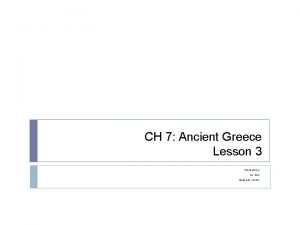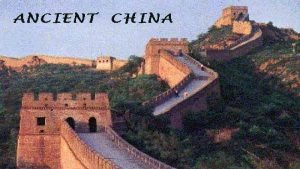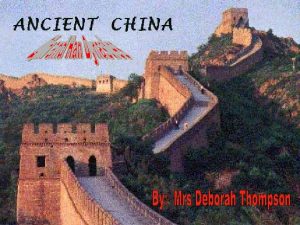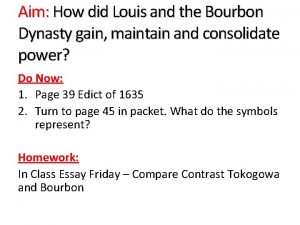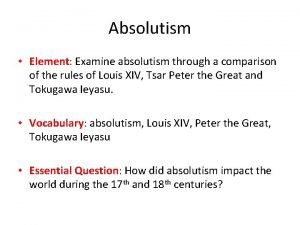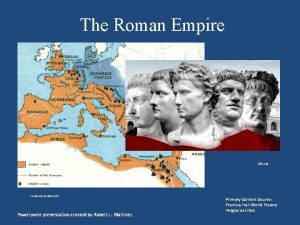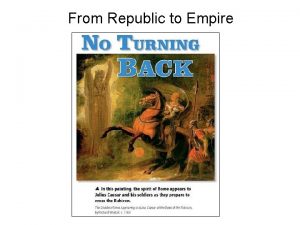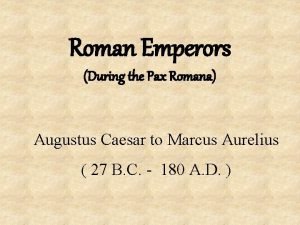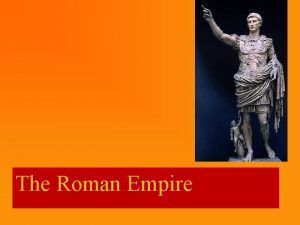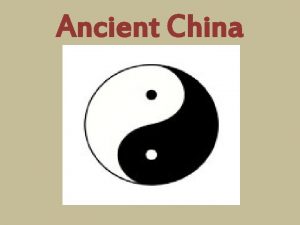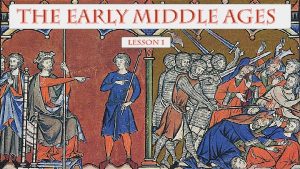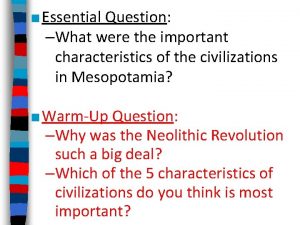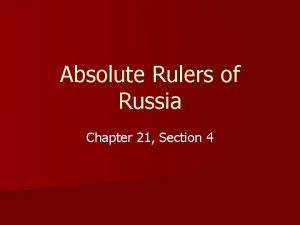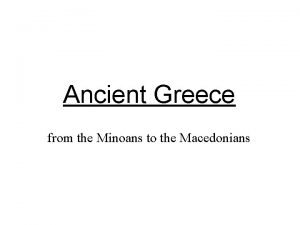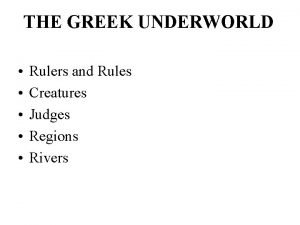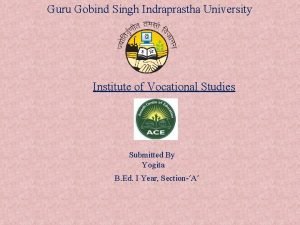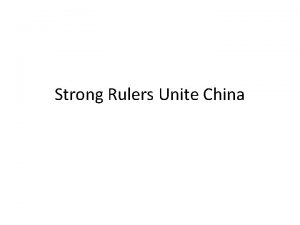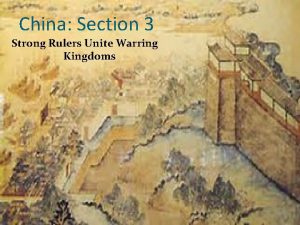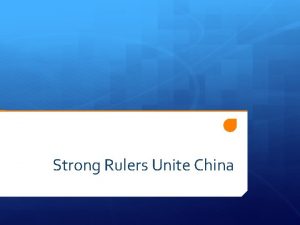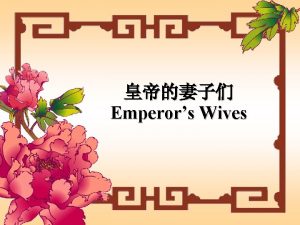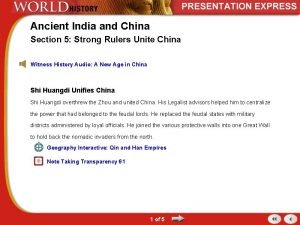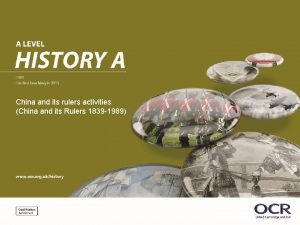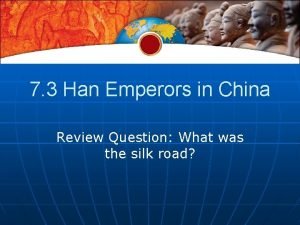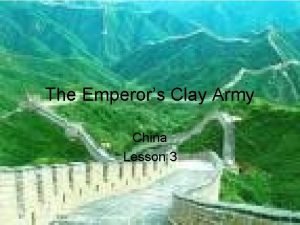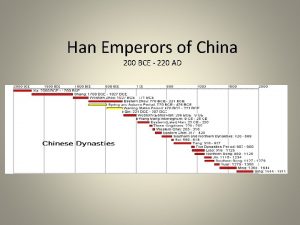Strong Rulers Unite China How did powerful emperors





































- Slides: 37

Strong Rulers Unite China How did powerful emperors unite much of China and bring about a golden age of cultural achievements?

Shi Huangdi Unifies China Shi Huangdi was determined to end the divisions that had splintered Zhou China. He spent nearly 20 years conquering most of the warring states. Then, imposing punishments for failure, he built the strong, authoritarian Qin government.

Legalism Establishes Harsh Rule Shi Huangdi centralized power with the help of Legalist advisers. Legalism was based on the teachings of Hanfeizi (hahn fay dzuh), who had died in 233 B. C. According to Hanfeizi, “the nature of man is evil. His goodness is acquired. . Hanfeizi insisted that the only way to achieve order was to pass strict laws and impose harsh punishments for crimes

To Legalists, strength, not goodness, was a ruler’s greatest virtue. “The ruler alone possesses power, ” declared Hanfeizi, “wielding it like lightning or like thunder. ” Many feudal rulers chose Legalism as the most effective way to keep order.

Shi Huangdi made it the official policy of the Qin government. He then moved harshly against his critics. He tortured, killed, or enslaved many who opposed his rule. Hardest hit were the feudal nobles and Confucian scholars who loathed his laws.

To end dissent, Shi Huangdi approved a ruthless campaign of book burning, ordering the destruction of all writings other than manuals on topics such as medicine and agriculture. Laws such as these were so cruel that later generations despised Legalism. Yet Legalist ideas survived for hundreds of years in laws that forced people to work on government projects and punished those who shirked their duties.

Unity Imposed Shi Huangdi also abolished feudalism, which required little allegiance from local rulers to the central government. He replaced the feudal states with 36 military districts and appointed loyal officials to administer them. Shi Huangdi forced noble families to live in his capital at Xianyang (shyahng), where he could monitor them. He distributed the lands of the displaced nobles to peasants. Still, peasants had to pay high taxes to support Shi Huangdi’s armies and building projects.

To promote unity, the First Emperor standardized weights and measures and replaced the diverse coins of the Zhou states with Qin coins. He also had scholars create uniformity in Chinese writing. Workers repaired and extended roads and canals to strengthen the transportation system. A new law even required cart axles to be the same width so that wheels could run in the same ruts on all Chinese roads.

Constructing the Great Wall Shi Huangdi’s most remarkable and costly achievement was the Great Wall. In the past, individual feudal states had built walls to defend their lands against raiders. Shi Huangdi ordered the walls to be joined. Hundreds of thousands of laborers worked for years through bitter cold and burning heat. They pounded earth and stone into a mountainous wall almost 25 feet high and topped with a wide brick road. Many workers died in the harsh conditions

Over the centuries, the wall was extended and rebuilt many times. Eventually, it snaked for thousands of miles across northern China. While the wall did not keep invaders out of China, it did demonstrate the emperors’ ability to mobilize China’s vast resources.

Qin Dynasty Collapses When Shi Huangdi died in 210 B. C. , anger over heavy taxes, forced labor, and cruel policies exploded into revolts. As Qin power officially collapsed in 206 B. C. , Gao Zu (gow dzoo), an illiterate peasant leader, defeated rival armies and founded the new Han dynasty four years later

The Han Dynasty Strengthens China As emperor, Gao Zu set about restoring order and justice to his empire. Although he continued earlier efforts to unify China, he lowered taxes and eased Legalist policies. In a key move, he appointed Confucian scholars as advisors. His policies created strong foundations for the Han dynasty, which lasted from 202 B. C. until A. D. 220

Emperor Wudi Makes Improvements The most famous Han emperor, Wudi (woo dee), took China to new heights. During his long reign from about 141 B. C. to 87 B. C. , he strengthened the government and economy. Like Gao Zu, he chose officials from Confucian “men of wisdom and virtue. ” To train scholars, he set up an imperial university at Xian (shyahn).

Wudi furthered economic growth by improving canals and roads. He had granaries set up across the empire so the government could buy grain when it was abundant and sell it at stable prices when it was scarce. He reorganized finances and imposed a government monopoly on iron and salt. A monopoly is the complete control of a product or business by one person or group. The sale of iron and salt gave the government a source of income other than taxes on peasants.

Wudi followed a policy of expansionism, or expanding a country’s territory, by increasing the amount of land under Chinese rule. He fought many battles to expand China’s borders and to drive nomadic peoples beyond the Great Wall. Chinese armies added outposts in Manchuria, Korea, northern Vietnam, Tibet, and Central Asia. Soldiers, traders, and settlers slowly spread Chinese influence across these areas.

Silk Road Links China to the West The emperor Wudi opened up a network of trade routes, later called the Silk Road, that would link China and the West for centuries. During the Han period, new foods such as grapes, figs, cucumbers, and walnuts flowed into China from western Asia. Lucky traders might return to China bearing furs from Central Asia, muslin from India, or glass from Rome. At the same time, the Chinese sent large quantities of silk westward to fill a growing demand for the prized fabric.

Eventually, the Silk Road stretched for 4, 000 miles, linking China to the Fertile Crescent in the Middle East. Few traders covered the entire distance, however; instead, goods were relayed in stages from one set of traders to another. At the western end, trade was controlled by various peoples, including the Persians.

China Selects Scholar-Officials Han emperors made Confucianism the official belief system of the state. They relied on well-educated scholars to run the bureaucratic government. A scholar-official was expected to match the Confucian ideal of a gentleman. He would be courteous and dignified and possess a thorough knowledge of history, music, poetry, and Confucian teachings.

Founding the Civil Service System Han emperors adopted the idea that civil servants—that is, officials in the government—should win their positions by merit, rather than through family ties as had occurred in the past. I n the Han civil service system, a young man would start in a clerical job. Once he proved his abilities, he would move up in local government. If he continued to excel, he would eventually be recruited into the civil service and might be tested on his knowledge of government policy

Much later, in the 580 s, the Sui dynasty set up a formal system of civil service exams, which were given at the local, provincial, and national levels. In theory, any man could take the exams. In practice, only those who could afford years of study, such as the sons of wealthy landowners or officials, could hope to succeed.

Occasionally, a village or wealthy family might pay for the education of a brilliant peasant boy. If he passed the exams and obtained a government job, he, his family, and his clan all enjoyed immense prestige and moved up in society. Confucian teachings about filial piety and the superiority of men prevented women from taking the civil service exam. As a result, women were excluded from government jobs.

The civil service system remained in use until 1912. It put men trained in Confucian thought at every level of government and created an enduring system of values. Dynasties rose and fell, but Confucian influence survived.

Han Empire Overthrown As the Han dynasty aged, signs of decay appeared. Court intrigues undermined emperors who could no longer control powerful warlords, or local military rulers. Weak emperors let canals and roads fall into disrepair. Burdened by heavy taxes and crushing debt, many peasants revolted. secret groups of bandits known by colorful names like the “Red Eyebrows” and the “Green Woodsmen. ”

In A. D. 220, ambitious warlords overthrew the last Han emperor. After 400 years of unity, China broke up into several kingdoms. Adding to the disorder, invaders poured over the Great Wall and set up their own states.

Achievements of the Han Golden Age The Han period was one of the golden ages of Chinese civilization. Han China made such tremendous advances in so many fields that the Chinese later called themselves “the people of Han. ”

Advancing Science and Medicine Han scientists wrote texts on chemistry, zoology, botany, and other subjects. One scientist invented a simple seismograph to detect and measure earthquakes

Chinese physicians diagnosed diseases, developed anesthetics, and experimented with herbal remedies and other drugs

Forging Ahead With Technology and Engineering In its time, Han China was the most technologically advanced civilization in the world. Cai Lun (ky loon), an official of the Han court, invented a method for making paper out of wood pulp. His basic method is still used to manufacture paper today.

The Chinese also pioneered advanced methods of shipbuilding and invented the rudder to steer.

Expanding the Arts The walled cities of Han China boasted splendid temples and palaces amid elegant parks. Bronze-workers and silk-makers improved on earlier techniques and set high standards for future generations

Lessons for Women, a handbook of behavior written by Ban Zhao (bahn jow) around A. D. 100, carefully spells out the proper behavior for women and men. Ban Zhao favored equal education for boys and girls. However, she stressed that women should be obedient, respectful, and submissive. “Let a woman modestly yield to others, ” she advised. “Let her respect others. ”

The Chinese Accept Buddhism By A. D. 100, missionaries and merchants had spread Mahayana Buddhism from India into China. At first, the Chinese had trouble with the new faith. For example, Chinese tradition valued family loyalty, while Buddhism honored monks and nuns who gave up the benefits of family life for a life of solitary meditation.

Despite obstacles such as this, Buddhism became increasingly popular, especially in times of crisis. Its great appeal was the promise of escape from suffering. Mahayana Buddhism offered the hope of eternal happiness and presented the Buddha as a compassionate, merciful god. Through prayer, good works, and devotion, anyone could hope to gain salvation. Neither Daoism nor Confucianism emphasized this idea of personal salvation.

By A. D. 400, Buddhism had spread throughout China. Buddhist monasteries became important centers of learning and the arts. Buddhism absorbed many Confucian and Daoist traditions. Chinese Buddhist monks stressed filial piety and honored Confucius.

In Mahayana Buddhism, people hope to become bodhisattvas, or enlightened people, who help others gain salvation. The bodhisattva of compassion and mercy (above), called Kuan-yin in China, is one of the most popular.

Looking Ahead Shi Huangdi, Gao Zu, Wudi, and later Han rulers forged a vast and varied land into a united China. Han rulers created an empire roughly the size of the continental United States. During this period, Chinese officials established the system of administration that would survive until 1912.

In coming centuries, China would undergo great changes. It would break up and be painfully reassembled over and over. On the whole, however, Chinese civilization would flourish. After periods of disunity, in A. D. 581 a new dynasty, the Sui, would turn to Confucian scholars to revive the days of Han greatness.
 How did persian rulers unite their vast empire?
How did persian rulers unite their vast empire? Helped overthrow the qin dynasty
Helped overthrow the qin dynasty Qin
Qin Ephesians 6:10-20 nkjv
Ephesians 6:10-20 nkjv How did louis xiv gain, consolidate, and maintain power?
How did louis xiv gain, consolidate, and maintain power? What is absolutism
What is absolutism How did these three absolute rulers eliminate competition?
How did these three absolute rulers eliminate competition? A strong desire to be successful
A strong desire to be successful How did otto von bismarck unite germany
How did otto von bismarck unite germany Indicator used in strong acid and weak base
Indicator used in strong acid and weak base Strong acid titration curve
Strong acid titration curve How to remember strong acids and strong bases
How to remember strong acids and strong bases Weak acid and strong base titration curve
Weak acid and strong base titration curve Strong base
Strong base Net ionic equation
Net ionic equation Pbs ancient rome
Pbs ancient rome Rome becomes a republic
Rome becomes a republic Emperors during pax romana
Emperors during pax romana Roman emperors
Roman emperors Introduction to information security chapter 2
Introduction to information security chapter 2 Good roman emperors
Good roman emperors Why was wudi called the martial emperor
Why was wudi called the martial emperor Metternichian
Metternichian Constantinople trade routes
Constantinople trade routes Why did constantinople become a rich and powerful city
Why did constantinople become a rich and powerful city Sumerian rulers
Sumerian rulers Chapter 21 section 4 absolute rulers of russia
Chapter 21 section 4 absolute rulers of russia Six rulers nfl team
Six rulers nfl team The rulers of the minoans were ________.
The rulers of the minoans were ________. Absolute rulers of russia
Absolute rulers of russia Books pencils rulers bags
Books pencils rulers bags Chapter 5 section 4 absolute rulers of russia answer key
Chapter 5 section 4 absolute rulers of russia answer key Italy birthplace of the renaissance
Italy birthplace of the renaissance Ming rulers
Ming rulers 3 judges of the underworld
3 judges of the underworld China a
China a Kelas bk smpit lhi
Kelas bk smpit lhi European rulers denounced the french revolution because
European rulers denounced the french revolution because
